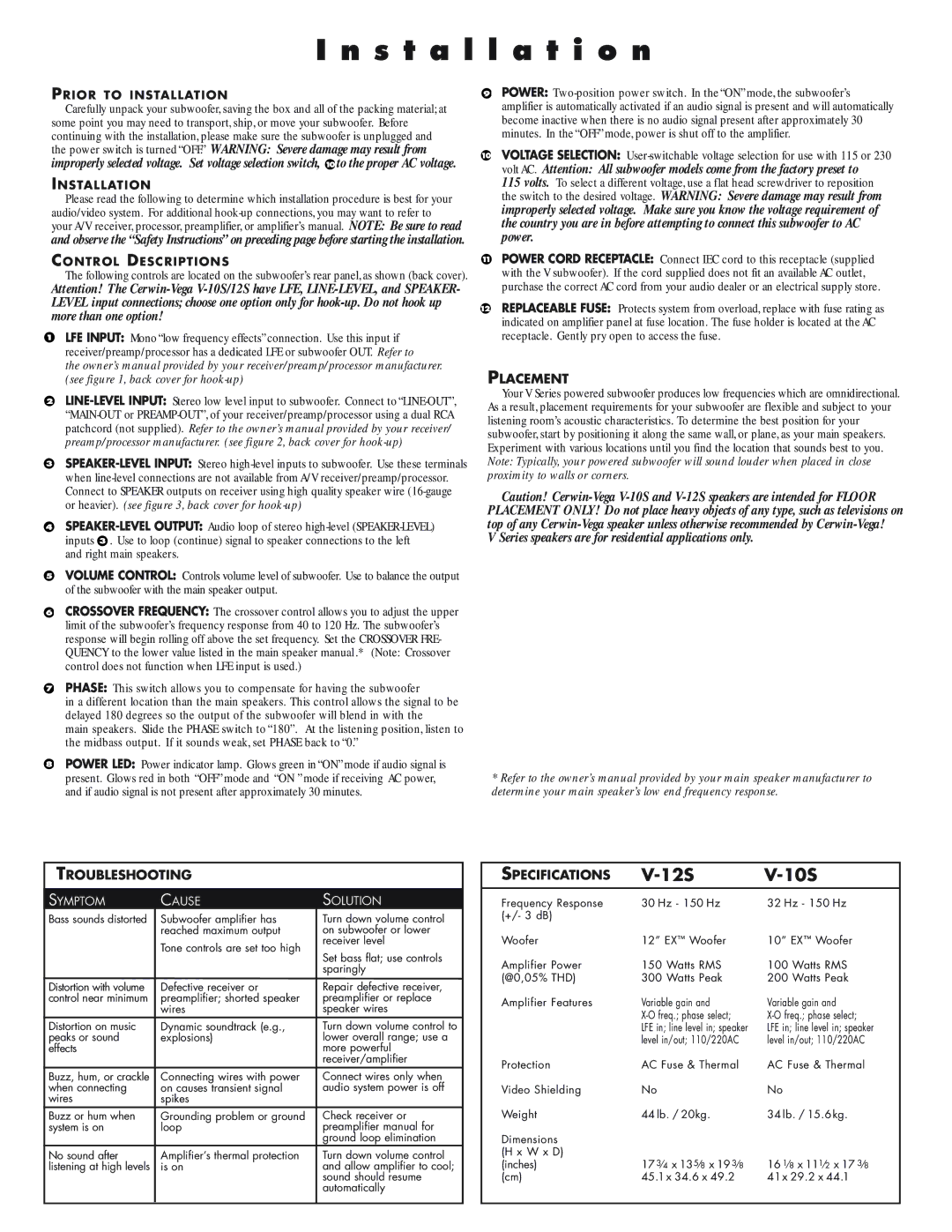
I n s t a l l a t i o n
PRIOR TO INSTALLATION
Carefully unpack your subwoofer,saving the box and all of the packing material;at some point you may need to transport,ship,or move your subwoofer. Before
continuing with the installation,please make sure the subwoofer is unplugged and the power switch is turned “OFF.” WARNING: Severe damage may result from improperly selected voltage. Set voltage selection switch, 10 to the proper AC voltage.
INSTALLATION
Please read the following to determine which installation procedure is best for your audio/video system. For additional
your A/V receiver,processor,preamplifier,or amplifier’s manual. NOTE: Be sure to read and observe the “Safety Instructions” on preceding page before starting the installation.
CONTROL DESCRIPTIONS
The following controls are located on the subwoofer’s rear panel,as shown (back cover).
Attention! The
1LFE INPUT: Mono“low frequency effects”connection. Use this input if receiver/preamp/processor has a dedicated LFE or subwoofer OUT. Refer to
the owner’s manual provided by your receiver/preamp/processor manufacturer. (see figure 1, back cover for
2
3
4
5VOLUME CONTROL: Controls volume level of subwoofer. Use to balance the output of the subwoofer with the main speaker output.
6CROSSOVER FREQUENCY: The crossover control allows you to adjust the upper limit of the subwoofer’s frequency response from 40 to 120 Hz. The subwoofer’s
response will begin rolling off above the set frequency. Set the CROSSOVER FRE- QUENCY to the lower value listed in the main speaker manual.* (Note: Crossover control does not function when LFE input is used.)
7PHASE: This switch allows you to compensate for having the subwoofer
in a different location than the main speakers. This control allows the signal to be delayed 180 degrees so the output of the subwoofer will blend in with the
main speakers. Slide the PHASE switch to “180”. At the listening position, listen to the midbass output. If it sounds weak, set PHASE back to “0.”
8POWER LED: Power indicator lamp. Glows green in“ON”mode if audio signal is present. Glows red in both “OFF”mode and “ON ”mode if receiving AC power, and if audio signal is not present after approximately 30 minutes.
TROUBLESHOOTING
SYMPTOM | CAUSE | SOLUTION |
Bass sounds distorted | Subwoofer amplifier has | Turn down volume control |
| reached maximum output | on subwoofer or lower |
| Tone controls are set too high | receiver level |
| Set bass flat; use controls | |
|
| |
|
| sparingly |
Distortion with volume | Defective receiver or | Repair defective receiver, |
control near minimum | preamplifier; shorted speaker | preamplifier or replace |
| wires | speaker wires |
Distortion on music | Dynamic soundtrack (e.g., | Turn down volume control to |
peaks or sound | explosions) | lower overall range; use a |
effects |
| more powerful |
|
| receiver/amplifier |
Buzz, hum, or crackle | Connecting wires with power | Connect wires only when |
when connecting | on causes transient signal | audio system power is off |
wires | spikes |
|
Buzz or hum when | Grounding problem or ground | Check receiver or |
system is on | loop | preamplifier manual for |
|
| ground loop elimination |
No sound after | Amplifier’s thermal protection | Turn down volume control |
listening at high levels | is on | and allow amplifier to cool; |
|
| sound should resume |
|
| automatically |
|
|
|
9POWER:
10VOLTAGE SELECTION:
volt AC. Attention: All subwoofer models come from the factory preset to
115 volts. To select a different voltage,use a flat head screwdriver to reposition the switch to the desired voltage. WARNING: Severe damage may result from improperly selected voltage. Make sure you know the voltage requirement of the country you are in before attempting to connect this subwoofer to AC power.
11POWER CORD RECEPTACLE: Connect IEC cord to this receptacle (supplied with the V subwoofer). If the cord supplied does not fit an available AC outlet, purchase the correct AC cord from your audio dealer or an electrical supply store.
12REPLACEABLE FUSE: Protects system from overload,replace with fuse rating as indicated on amplifier panel at fuse location. The fuse holder is located at the AC receptacle. Gently pry open to access the fuse.
PLACEMENT
Your V Series powered subwoofer produces low frequencies which are omnidirectional. As a result,placement requirements for your subwoofer are flexible and subject to your listening room’s acoustic characteristics. To determine the best position for your subwoofer,start by positioning it along the same wall,or plane,as your main speakers. Experiment with various locations until you find the location that sounds best to you. Note: Typically, your powered subwoofer will sound louder when placed in close proximity to walls or corners.
Caution!
V Series speakers are for residential applications only.
*Refer to the owner’s manual provided by your main speaker manufacturer to determine your main speaker’s low end frequency response.
SPECIFICATIONS |
|
|
|
|
|
Frequency Response | 30 Hz - 150 Hz | 32 Hz - 150 Hz |
(+/- 3 dB) |
|
|
Woofer | 12” EX™ Woofer | 10” EX™ Woofer |
Amplifier Power | 150 Watts RMS | 100 Watts RMS |
(@0,05% THD) | 300 Watts Peak | 200 Watts Peak |
Amplifier Features | Variable gain and | Variable gain and |
| ||
| LFE in; line level in; speaker | LFE in; line level in; speaker |
| level in/out; 110/220AC | level in/out; 110/220AC |
Protection | AC Fuse & Thermal | AC Fuse & Thermal |
Video Shielding | No | No |
Weight | 44 lb. / 20kg. | 34 lb. / 15.6kg. |
Dimensions |
|
|
(H x W x D) | 17 3⁄4 x 13 5⁄8 x 19 3⁄8 | 16 1⁄8 x 111⁄2 x 17 3⁄8 |
(inches) | ||
(cm) | 45.1 x 34.6 x 49.2 | 41x 29.2 x 44.1 |
|
|
|
